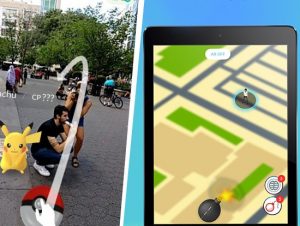In 2016, Niantic released Pokemon Go. In the game, gamers had to go to specific real-world locations to catch Pokemons or Pocket Monsters. Most of you might be familiar with these virtual creatures from the popular Nintendo game series and the equally popular Anime. Just like in both the games and anime, users could go to various locations and capture various Pokemon like Charmander, Squirtle, and Jigglypuff.
The augmented reality game became a global phenomenon just within hours after its release. It was such a huge hit at the time, that it set the record of becoming the app that made the highest revenue in its first week.
Since 2018, it has seen an increased interest in augmented reality as the technology becomes more easily available to users everywhere. In a nutshell, augmented reality(AR) works by layering 2D or 3D virtual content on top of real world locations and objects, which can be accessed using smart devices such as phones and tablets and also wearable technology such as smart glasses. Unlike virtual reality games and apps that need investment in dedicated headsets, augmented reality apps can work on commonly available smartphones and headsets. This paves the way for widespread distribution of AR apps. Consumer adoption of AR has created a thriving market for AR applications across all sectors, from popular social networking apps like SnapChat to product promotion apps like IKEA’s catalogue.

Most AR apps today fall into the first two categories – marker-based AR and location-based AR. Marker-based AR primarily uses image recognition features to display virtual information overlayed on specific objects.
Marker-less AR, also termed geo-location based AR refers to augmented reality features that are anchored on real-time location. Digital data is virtually placed over actual physical surroundings, allowing users to access it using AR ready devices such as smartphones. As of now all smartphones already come with location detection capabilities. With the release of Apple’s ARKit and Google’s ARCore, phones that support augmented reality applications are steadily becoming available to consumers everywhere. This will likely lead to more interest and scope for augmented reality geo-location apps.
There are several popular examples of geo-location based AR. Yelp is a popular one, using which you can get details of the restaurants near you including their star ratings by scanning the location around you using your camera within the app. Fieldtrip was one app, also created by Niantic, which acted as a virtual tour guide, augmenting various data onto real-world tourist attractions.
Geo-location based AR, however, is still in its infancy. There are several ways in which it might revolutionize the way we live.
Augmented reality geo-location apps are created using a combination of geospatial data determining mechanisms and AR tech. Geo markers (also called “points of interest) are first identified. The exact position of the smartphone is determined through queries to the relevant sensors on the device. Location is usually determined via GPS or beacon, along with the embedded digital compass and accelerometers in mobile devices The digital overlays or “augmentations” are virtual placed over the points of interest. These can include sound effects, animations, music, videos, images etc. Users can then activate and interact with the digital overlays based on their physical location.
Accuracy is a critical factor for creating functional geo location based Augmented Reality apps. Virtual information must be displayed on the screen irrespective of the angle of the camera (portrait, landscape or tilted). The GPS data used to triangulate the exact position of the user must also be error free. All AR features must be customized, calibrated for optimum user experience.
Location-based AR can be employed to create applications for a wide variety of purposes. As more smartphones come equipped with AR ready features, the potential audience for commercial apps gets larger every day. Here are some of the use cases for location-based AR apps.
Gaming and entertainment: The most well known use of location-based AR is in games like Pokemon GO and Ingress. Entertainment apps that make use of the player’s immediate surroundings and environment appeal to large audiences. Juego Studios has created a social AR Game for players to meet and interact within their locality. For more info visit : Augmented Reality Game & Social Platform
Marketing and promotion: AR apps can be used to display promotional information such as news about offers and sales whenever users are in close proximity to stores, restaurants etc. Juego Studios created GPS Treasure Hunt , a location-based AR scavenger hunt centered around promotional activities.
Utility apps: Navigation and way-finding apps can be enhanced using AR features to deliver more interesting information to users.
All these will make augmented reality a big thing in the future. Location-based augmented reality is just in its infancy. It has a long way to go.
And when this future is getting made, we at Juego Studio will be at the forefront of it. Juego Studios is an AR app development company that works with both marker-based and marker-less technology. We has a team of dedicated AR developers who have created numerous AR applications and games across platforms.We understand the nuances of geo-location based AR and create games and solutions that take advantage of the uniqueness of this medium.